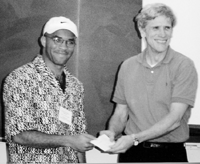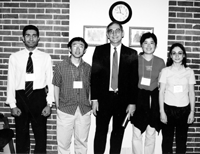By Students for Students: SIAM Gators Welcome Chapters Nationwide to Florida Conference
October 26, 2004

Virginia Tech undergraduate Firmin Ndeges---the only undergraduate to speak at the student conference---received one of the two best-presentation awards given by the organizers. (The other recipient, Dionisio Fleitas of the University of Texas, Arlington, is not pictured.) Ndeges is shown here accepting the congratulations of William Hager, a faculty adviser of the SIAM Gators.
Formed in October 2002 at the University of Florida, the SIAM Gators soon became a model SIAM student chapter. The approximately twenty participating graduate students organized seminars, initially allowing student speakers only and later making way for a faculty speaker from time to time, and they held a potluck dinner at least once a semester. These activities drew the graduate students and faculty closer together, chapter members Beyza Aslan and Hongchao Zhang told SIAM News in Portland during the SIAM Annual Meeting.
As the mathematics department's plans for a special year in applied mathematics (2003-04) were taking shape, Aslan asked what seemed to be a natural question: Why don't we hold a student conference in conjunction with one of the special-year conferences?
Her question set in motion several months of hard work for herself, Zhang, and their six co-organizers (Jung-ha An, Weihong Guo, Feng Huang, Shu-Jen Huang, Sukanya Krishnaswamy, and Adnan Sabuwala ), all graduate students at UFL. The result was a two-day student conference, SIAM Gators Student Conference, held March 3 and 4 at the University of Florida.
"We did everything but submit the funding proposal," Aslan said in Portland. She and Zhang looked back with considerable satisfaction at what they had achieved, with the help of faculty advisers William Hager and Shari Moskow and support from the National Science Foundation ($9000 for speaker expenses).
What exactly did the organizers do? Nudged by a (carefully preserved) note from Hager to the effect that time was passing, the students began by issuing a statement to all universities with SIAM student chapters inviting students to submit proposals for talks; preference would be given, they explained, to presenters in the areas of optimization, imaging, homogenization, and finite element methods---the themes of the special year at the university.
After what seemed a painfully long time, proposals began to arrive (including one from a student in India, who ended up attending with partial support he arranged on his own). The students then went to work selecting speakers; in the end, the program featured 17 student speakers/poster presenters from all over the U.S. (and one from India), along with eight from the University of Florida. The organizers decided on 20-minute talks, with five additional minutes for questions and discussion, scheduled by theme into two morning and two afternoon sessions.
The students put together a printed program, complete with abstracts of all the talks, including those of the two faculty speakers, Terry Rockafellar of the University of Washington ("Optimization in the Face of Risks," introduced by Donald Hearn, chair of the Department of Industrial and Systems Engineering) and Biswa Nath Datta of the University of Northern Illinois ("Recent Developments on Computational Methods for Inverse Eigenvalue Problems for Quadratic Matrix and Operator Pencils," introduced by Krishnaswamy Alladi, chair of the Department of Mathematics). A member of the organizing committee chaired each of the conference sessions.
The students had planned to award a prize for the best presentation. In the end, they presented two, one to Dionisio Fleitas, a PhD student at the University of Texas at Arlington, and the other to Firmin Ndeges, an undergraduate---the only one on the program---at Virginia Polytechnic Institute.
Fleitas had used a least-square finite element adaptive grid method to solve a one-dimensional nonlinear time-dependent problem, improving the solution at each timestep by resolving the problem on a deformed grid. His numerical results showed substantial improvement of the solution with a boundary layer. Ndeges presented work done in part under the supervision of Terry Herdman (who attended the conference, Aslan and Zhang were happy to report) in which he showed that the addition of discontinuities to the standard trigonometric basis functions can mitigate the highly oscillatory Gibbs phenomenon that occurs in the Fourier approximation of piecewise-continuous functions.
In addition to the technical program, conference goers enjoyed a banquet at the local Olive Garden the first night of the conference. Many of the students also took the opportunity to attend two of the special-year conferences being held at the same time, Multiscale Optimization Methods and Applications, organized by Hager, and Computational Methods in Multiscale Analysis and Applications, organized by Moskow and Jay Gopalakrishnan; the latter included a special lecture by Stephen Smale.
As a final conference-related task, the students will edit the conference proceedings, which will be published by Kluwer. Over all, they consider SIAM's first-ever student-organized conference to have been a great success, bringing SIAM student chapters from all over the U.S. together in an interactive environment.
Asked in Portland whether they would have done anything differently, Aslan had a ready response: "Take more pictures!"
Looking to the future, Aslan described the Florida students' experience at the student chapter session in Portland, ending with the suggestion that student conferences become a regular event, with the organizing duties revolving among the SIAM student chapters. If she and her co-organizers are willing to share their expertise---which seems certain to be the case-her idea should have a good chance of becoming a reality.

Taking time during the conference to pose with Kenneth Gerhardt, dean of the graduate school at the University of Florida (center), are organizing committee members, from left, Adnan Sabuwala, Hongchao Zhang, Jung-ha An, and Beyza Aslan.

